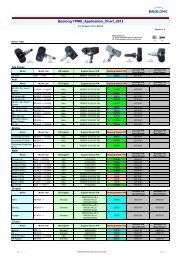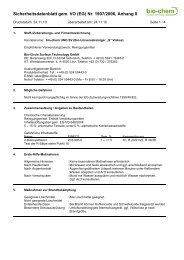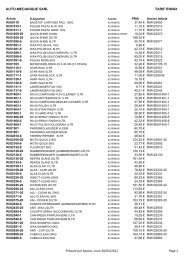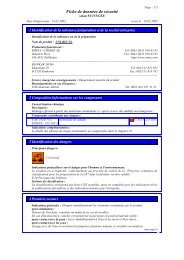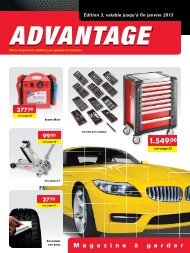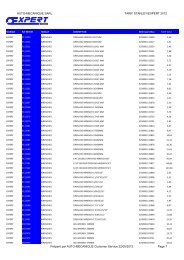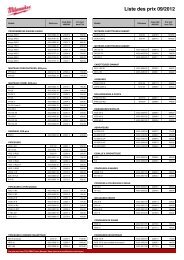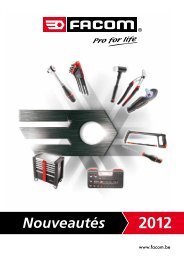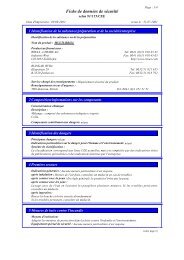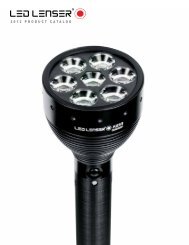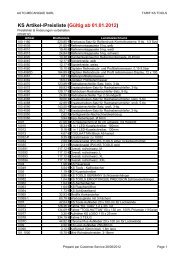REPAIR & SUPPLIES - Auto-Mecanique
REPAIR & SUPPLIES - Auto-Mecanique
REPAIR & SUPPLIES - Auto-Mecanique
Create successful ePaper yourself
Turn your PDF publications into a flip-book with our unique Google optimized e-Paper software.
Industry standard Puncture repair procedures<br />
Non-Repairable Conditions +<br />
Prior to repairing any tire, a careful inspection should be conducted using a grazing light<br />
method on both the inside and outside of the tire. According to the “Industry Standards for<br />
Tire Repairing”, any tire exhibiting the following conditions should not be accepted for repair.<br />
External<br />
• Exposed cords beyond repairable limits<br />
• Separations beyond repairable limits<br />
• Broken belts<br />
• Excessive oxidation (weather checking) extending<br />
to the body plies<br />
• Damage which exceeds the size of a repairable<br />
injury or requires the repairs to overlap in radial<br />
tires or that are in the same quadrant in bias tires<br />
• Broken or kinked beads<br />
• Damaged bead exposing bead wire<br />
• Injuries beyond the repairable limits<br />
• Tire with less than 2/32” (2mm) nonskid<br />
remaining unless retreading is planned<br />
• Previously installed repairs found to be<br />
defective and unrepairable<br />
• Radial tires with rust or corrosion beyond<br />
repairable limits<br />
Internal<br />
• Injuries beyond repairable limits<br />
• Porous or loose liners<br />
• Open liner splices beyond repairable limits<br />
• Loose cords on the inside ply or evidence of<br />
having been run underinflated or overloaded<br />
• Injury to the ply cord beyond repairable limits<br />
+ Reprinted with permission of ITRA<br />
TIRE INSPECTION<br />
EXTERNAL EXAMINATION<br />
1. Carefully remove the wheel from the vehicle following<br />
industry recommended practices.<br />
2. Inflate the tire to the manufacturer’s recommended<br />
operating pressure (found on the sidewall of the tire).<br />
3. Immerse the tire in a test tank to find the damaging leak.<br />
In some cases there may be a high pressure leak (one<br />
which has its greatest effect when under the full load of<br />
the vehicle) and it may be necessary to use leak detector<br />
to find the damaging object. Be certain to inspect<br />
for the possibility of more than one leak.<br />
4. Review the Non-Repairable External Conditions above.<br />
If the tire has been determined to be repairable, mark<br />
the location of the injury on the outside of the tire using<br />
a tire marking crayon. If you have any doubts as to the<br />
repairability of the tire, do not proceed with the repair.<br />
INTERNAL EXAMINATION<br />
5. Demount the tire from the wheel and place it on<br />
the floor in front of you.<br />
6. Review the Non-Repairable Internal Conditions<br />
above. If the tire has been determined to be repairable,<br />
mark the location of the injury on the inside of<br />
the tire using a tire marking crayon.<br />
7. Remove the object causing the injury and carefully<br />
probe the injury to make sure it is 1/4” or less in<br />
diameter in passenger tires and 3/8” or less in light<br />
and medium truck tires. If these limits are exceeded,<br />
take the tire to a full service repair facility to be<br />
considered for section repair.<br />
8. Using a probe, push it into the injury from the outside<br />
of the tire until the probe extends 1/4” through<br />
the innerliner. Be careful not to create a new hole.<br />
9. With the probe extending through the injury channel<br />
and the injury at the 12 o’clock position, place<br />
the Patch-Plug Gauge across the tread next to the<br />
probe, with the center of the gauge placed at the<br />
center point of the injury.<br />
10. If the shaft of the probe is within the gray area<br />
(25° or less), a one-piece repair may be used<br />
(patch-plug combination unit).<br />
11. If the shaft of the probe is within the red area<br />
(greater than 25°), a two-piece repair is required<br />
(separate repair unit and insert).<br />
12. Place the tire on a spreader with the injury in the<br />
4 or 8 o’clock position. Do NOT spread the beads<br />
too far, as this will distort the final repair.<br />
Tire repair DVD's available from 31 Inc.<br />
Ask for details<br />
112



